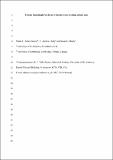Files in this item
Female hummingbirds do not relocate rewards using colour cues
Item metadata
| dc.contributor.author | Tello Ramos, Maria Cristina | |
| dc.contributor.author | Hurly, T. Andrew | |
| dc.contributor.author | Healy, Susan D. | |
| dc.date.accessioned | 2015-06-01T23:10:53Z | |
| dc.date.available | 2015-06-01T23:10:53Z | |
| dc.date.issued | 2014-07 | |
| dc.identifier | 155013239 | |
| dc.identifier | ae71ff86-bea3-4866-989a-98c5cf924940 | |
| dc.identifier | 000338712900016 | |
| dc.identifier | 84901506712 | |
| dc.identifier | 000338712900016 | |
| dc.identifier.citation | Tello Ramos , M C , Hurly , T A & Healy , S D 2014 , ' Female hummingbirds do not relocate rewards using colour cues ' , Animal Behaviour , vol. 93 , pp. 129-133 . https://doi.org/10.1016/j.anbehav.2014.04.036 | en |
| dc.identifier.issn | 0003-3472 | |
| dc.identifier.other | ORCID: /0000-0002-8059-4480/work/60631294 | |
| dc.identifier.uri | https://hdl.handle.net/10023/6724 | |
| dc.description | This research was supported by CONACYT (The Mexican National Council for Science and Technology) grant number: 310717, the University of Lethbridge and the Natural Sciences and Engineering Research Council of Canada (grant number: RGPIN 121496-2003) and the University of St Andrew's Russell Trust Award. | en |
| dc.description.abstract | Males generally outperform females in spatial tasks. This difference in spatial performance may reflect differences in cue preference because males often use both spatial cues 9distance and direction) and feature cues, whereas females prefer to use feature cues. However, studies in birds are few and results are conflicting. As wild male rufous hummingbirds, Selasphorus rufus, prefer to use spatial cues to relocate a rewarded flower, in the present study we tested free-flying wild female hummingbirds of three different species 9rufous, white-eared, Hylocharis leucotis, and magnificent hummingbird, Eugenes fulgens) and males of one species 9white-eared) for their cue preference in the same task in which rufous males have been tested previously. Birds were allowed to feed once from a four-flower array in which only one flower was rewarded. When the birds returned, the colour and the spatial cue designating the rewarded flower had been dissociated. Although we had expected females to visit the flower of the correct colour 9feature cue) first, during the test phase most of the birds 9males and females) went to the correct spatial location 9spatial cue). It appears, then, that preference for spatial cues is not specific to males and it seems more likely to depend on the relevance or value of a cue to the solution of the task. (C) 2014 The Association for the Study of Animal Behaviour. Published by Elsevier Ltd. All rights reserved. | |
| dc.format.extent | 5 | |
| dc.format.extent | 249098 | |
| dc.language.iso | eng | |
| dc.relation.ispartof | Animal Behaviour | en |
| dc.subject | Cue preference | en |
| dc.subject | Magnificent hummingbird | en |
| dc.subject | Rufous hummingbird | en |
| dc.subject | Sex differences | en |
| dc.subject | Spatial memory | en |
| dc.subject | White-eared hummingbird | en |
| dc.subject | Sex-differences | en |
| dc.subject | Spatial ability | en |
| dc.subject | Rufous hummingbirds | en |
| dc.subject | Memory | en |
| dc.subject | Competition | en |
| dc.subject | Hypothesis | en |
| dc.subject | Cognition | en |
| dc.subject | Flowers | en |
| dc.subject | Women | en |
| dc.subject | Task | en |
| dc.subject | QH301 Biology | en |
| dc.subject.lcc | QH301 | en |
| dc.title | Female hummingbirds do not relocate rewards using colour cues | en |
| dc.type | Journal article | en |
| dc.contributor.institution | University of St Andrews. School of Biology | en |
| dc.contributor.institution | University of St Andrews. Institute of Behavioural and Neural Sciences | en |
| dc.contributor.institution | University of St Andrews. Centre for Social Learning & Cognitive Evolution | en |
| dc.contributor.institution | University of St Andrews. Centre for Biological Diversity | en |
| dc.identifier.doi | 10.1016/j.anbehav.2014.04.036 | |
| dc.description.status | Peer reviewed | en |
| dc.date.embargoedUntil | 2015-06-02 |
This item appears in the following Collection(s)
Items in the St Andrews Research Repository are protected by copyright, with all rights reserved, unless otherwise indicated.

